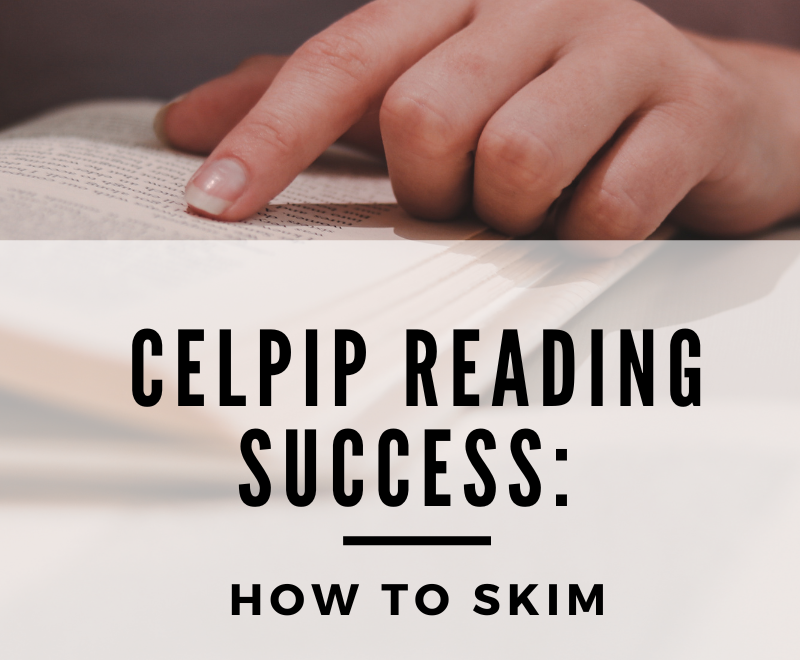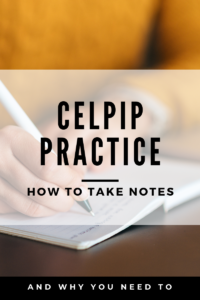Two of the most important skills to master for the reading section of the CELPIP exam are Skimming and Scanning.
In fact, these two skills will help you as you develop your reading skills in general in English.

How I Discovered Skimming
A few years ago I was studying in a Master’s degree program through my workplace. There was LOTS of reading to do, as I’m sure you can imagine.
Some of the books we needed to work with were easy to read. They were short, and dealt with subject matter that I found easy to understand. Thankfully, I was also usually very interested in the subject matter I was reading about, so that helped me work my way through each book quickly.
But not all the books were short! And sadly, not all the books were interesting to read.
I can remember one massive book in particular – it was huge! And worse: it was kind of boring in places. Like so boring I remember jumping to my feed and screaming: “I can’t take it anymore!” And I threw it on the sofa where I had been sitting.
But I couldn’t stop because I had to submit an 18 page research paper about it in a few weeks. I had to keep going. (It was terrible!)
That’s when I discovered how important skimming can be!
I decided, in order to keep my sanity, that I would only skim through the chapters that were not that interesting to me.
I still had to push myself hard to not give up, but skimming made a huge difference vs trying to read through every single boring word!
Why Skimming is Helpful?
Learning how to skim will help you to move quickly through the text to create a sort of mental map about where key information can be found in the article you’re working with. This will help you answer some of the questions you’re going to be asked on the exam because you’ll have a rough idea of where to find it in the text. Here’s a quick crash course on skimming!
Don’t Read Every Word!
Skimming means you don’t read every single word in the text. Instead, you focus on article headings, as well as the first and last sentence of each paragraph.
You also should focus on reading words or phrases that are in italics – like these ones. The reason? If they’re different than the rest of the text, it may signal that it’s talking about something important!
Read sentences that have words in bold.
How to Scan
The second sill you need to work to master is called Scanning.
Scanning will help you zoom in on the text like a camera lens. You’re quickly looking for specific information or details.
Remember: You’re working against the clock on the CELPIP exam. You don’t need to read every single word in the text when you’re scanning.
Here’s what you need to do:
- Start with the questions! Focus on one question at a time. Look for a few key words or phrases in the question.
- When you have your key word(s), jump over to the text and quickly search for those words or phrases. When you find one, read the sentences around those words carefully. You likely found the answer you were looking for!
Here’s an important CELPIP Reading tip for you: The answers to the questions will go in order from top to bottom. What that means is this: the answer to the first question will likely be somewhere near the beginning of the text. The second answer will be somewhere under the first one, etc. (In other words, you won’t need to do much jumping around in the text to find the answers!)
In Summary:
Skimming is an important skill to help you quickly get a big picture idea of what the article/text is about.
Scanning is all about rapidly zooming in to find specific information. Use key words from the questions to help narrow your search!
Remember: Speed is important because you are working against the clock on the CELPIP exam. If you try to read every word, you could run out of time!
When you skim, remember to only read the following:
- Headings.
- The first and last sentences of each paragraph.
- Words or phrases that are in italics.
- Words or phrases that are in bold.
When you Scan:
- Locate key words in the questions.
- Answers to the questions will usually go in order in the text. The answer to question one will likely be somewhere near the beginning of the text, etc.
- Quickly scan for your key words or phrases in the text. When you see one, read the sentences around it. The answer to your question will likely be there!
- Practice!



[…] the first and last sentences of paragraphs, and any words that are in italics or bold. (See previous blog post on skimming and a podcast episode as […]